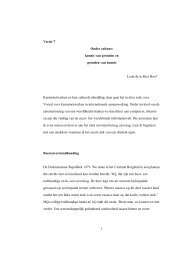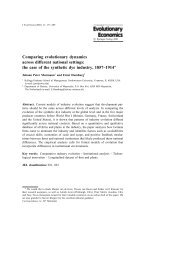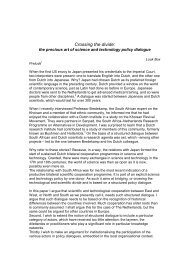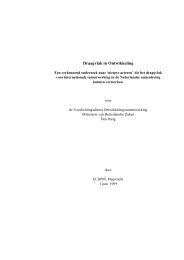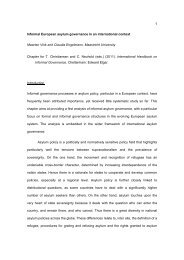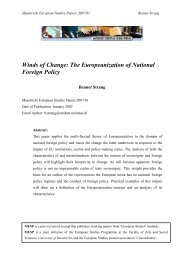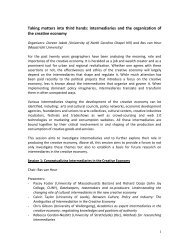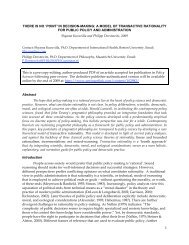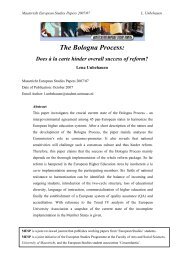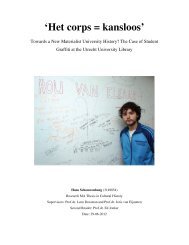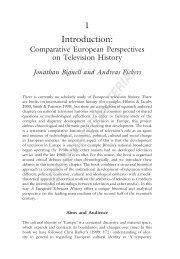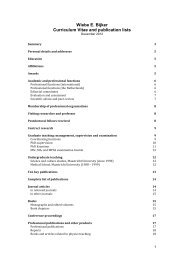About the Journal - Cities Institute
About the Journal - Cities Institute
About the Journal - Cities Institute
Create successful ePaper yourself
Turn your PDF publications into a flip-book with our unique Google optimized e-Paper software.
Discussion Paper<br />
‘What Do I Know?’: How British and Swedish Newspaper Art Critics Approach<br />
Contemporary African Art<br />
Henrik Lindén<br />
King‟s College London, Centre for Cultural, Media and Creative Industries Research<br />
This paper sets out to discuss <strong>the</strong> art critic as mediator of contemporary African art in<br />
Britain and Sweden. The paper will bring to <strong>the</strong> surface some ideas concerning art<br />
criticism and contemporary African art, and through examples from reviews of<br />
Africa Remix it will point out an important field of inquiry – <strong>the</strong> role of <strong>the</strong> newspaper<br />
art critic as protector of traditional eurocentric values.<br />
The discourse surrounding contemporary African art is not easily defined, and <strong>the</strong>re<br />
will be no attempts to do so in this limited space. However, to point out <strong>the</strong><br />
complexity of <strong>the</strong> field without being too elusive, <strong>the</strong> following quote serves as a<br />
general guide for what is referred to in this paper: “Contemporary African art<br />
denotes a field of complex artistic production, research, interpretation, and a<br />
repository of rich intellectual discovery at <strong>the</strong> intersection of <strong>the</strong> shifting models of<br />
cultural, political, social and epistemological analyses in which Africa is meaningfully<br />
interpolated” (Enwezor and Okeke-Agulu, 2009, p. 11).<br />
In <strong>the</strong> 1990s, large group exhibitions in Europe and North America played a big role<br />
in steering <strong>the</strong> field of contemporary African art away from an anthropological and<br />
ethnographic discourse, and into <strong>the</strong> field of international contemporary art. In <strong>the</strong><br />
wake of Magiciens de la Terre (Paris, 1989) – widely criticised for its focus on <strong>the</strong><br />
“primitive”, and adhering to an imperialistic view of non-European art (Deliss, 1995) –<br />
and Africa Explores (New York, 1991), with its celebration of <strong>the</strong> self-taught, and<br />
<strong>the</strong>refore more “au<strong>the</strong>ntic” artist (Kasfir, 1992; Deliss, 1995 and Enwezor and Okeke-<br />
Agulu, 2009), a more nuanced picture of contemporary African art emerged<br />
through exhibitions such as The Short Century (1994) and Seven Stories <strong>About</strong><br />
Modern Art in Africa (1995-1996). These, and more recent exhibitions including<br />
Au<strong>the</strong>ntic/Ex-Centric (2001), Looking Both Ways (2004) and Africa Remix (2004-2007),<br />
along with articles in journals such as Nka: <strong>Journal</strong> of Contemporary African Art and<br />
Third Text, have challenged old representations of Africa in art history, and also what<br />
Salah M. Hassan (2008) calls <strong>the</strong> “artificial boundaries” between nor<strong>the</strong>rn and sub-<br />
Saharan Africa. This exclusion of North Africa was widely accepted well into <strong>the</strong><br />
1980s (Vansina, 1988; Hassan, 2008 and Njami, 2005) and is still present today. The<br />
October Gallery in London, one of <strong>the</strong> leading galleries in Europe when it comes to<br />
promoting art from all over <strong>the</strong> world, chose to state on <strong>the</strong>ir website that <strong>the</strong> 2009<br />
exhibition Transvangarde included artists from Algeria and Africa (October Gallery,<br />
2009).<br />
Prior to <strong>the</strong> paradigm shift in <strong>the</strong> 1990s, private collectors often acted as curators for<br />
exhibitions of African art in museums, with no o<strong>the</strong>r selection criteria than <strong>the</strong>ir own<br />
taste (Picton, 1999). Consequently, private collectors have played a big part in <strong>the</strong><br />
33



